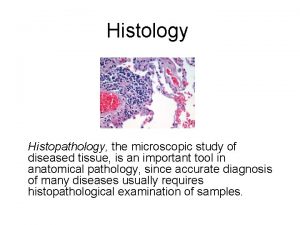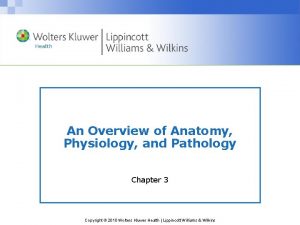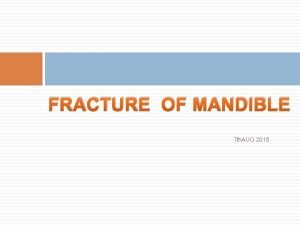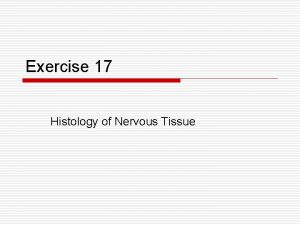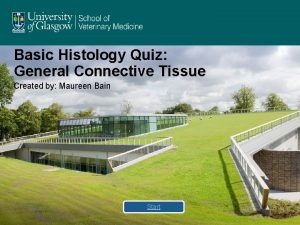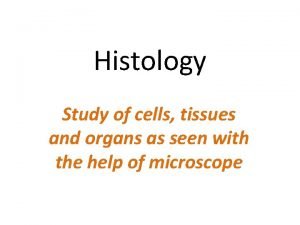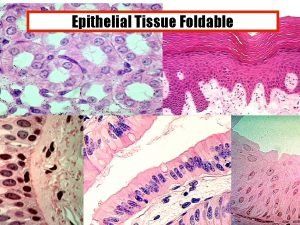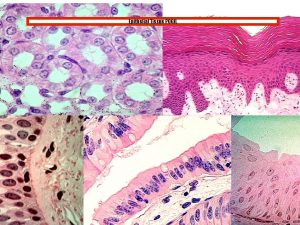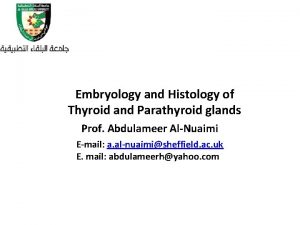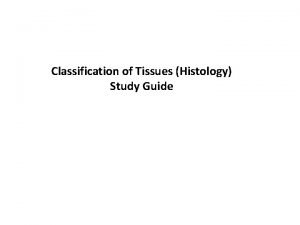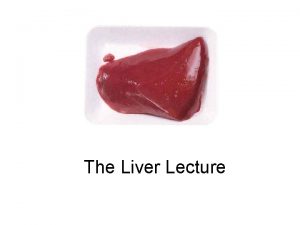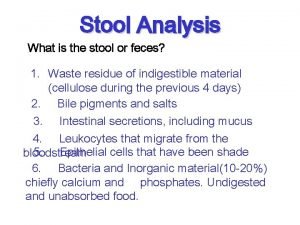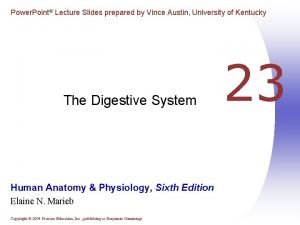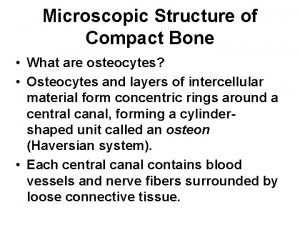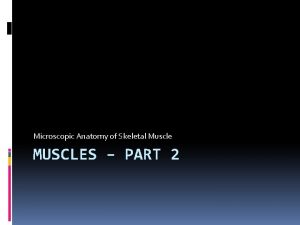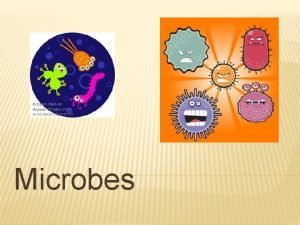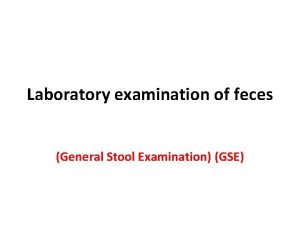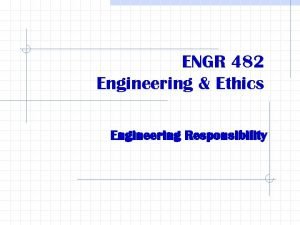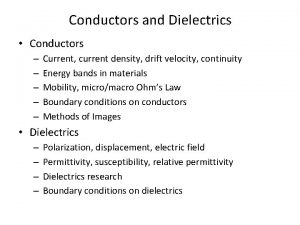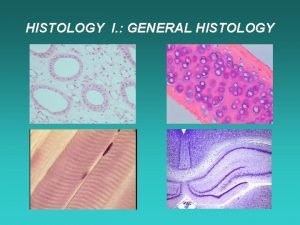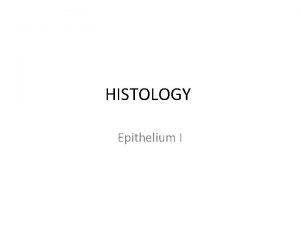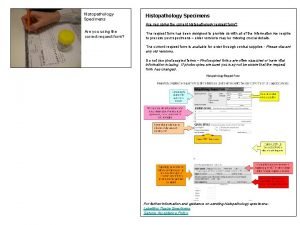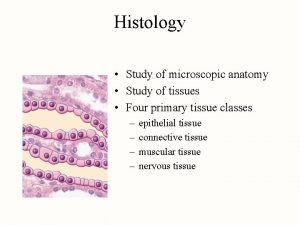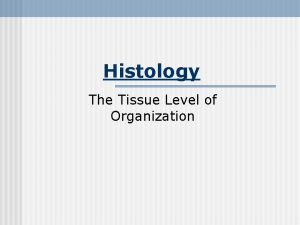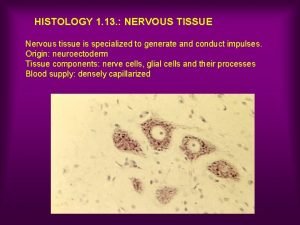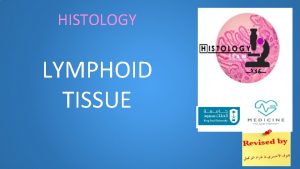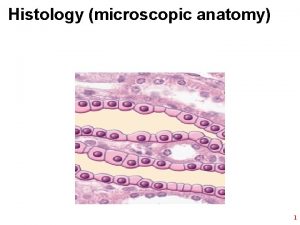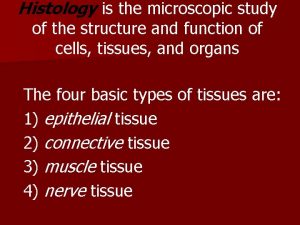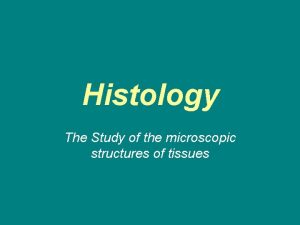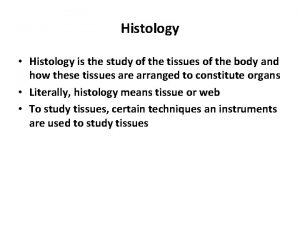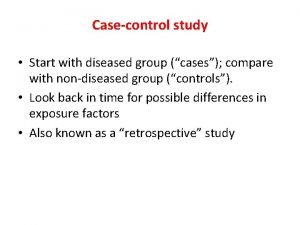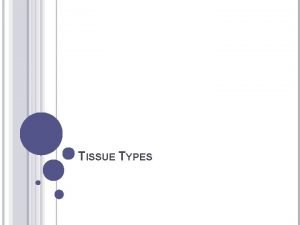Histology Histopathology the microscopic study of diseased tissue

























- Slides: 25

Histology Histopathology, the microscopic study of diseased tissue, is an important tool in anatomical pathology, since accurate diagnosis of many diseases usually requires histopathological examination of samples.

Histology Processing • Samples fix in 10% NBF. – 48 hrs -72 hrs -days

• Paraffin infiltration and embedding into blocks. • Cuts thin sections on slides (3 -5 um thick).

Deparaffinization and Rehydration

Stain tissue sections • Hematoxylin and eosin stain (H & E stain) – structures staining blue are called basophilic because of their affinity for the basic dye (hematoxylin) – structures staining pink are called acidophilic because of their affinity for the acid dye (eosin),

Liver • Hepatocytes – functional liver cells • Hepatic Sinusoids – small blood vessel within liver tissue • Hepatic Portal Vein – brings blood into the liver • Central Vein – takes blood out of the liver • Bile Duct – storage and drainage of bile • Arteriole – delivers blood from artery to capillaries • Glycogen Vacuole – used for glycogen storage

Liver Hepatic sinusoid Hepatocyte Glycogen vacuole 1000 X

Liver Hepatic sinusoids Erythrocytes visible within the central vein 400 x

Liver Arteriole 400 X

Liver Central vein RBC Arteriole

Liver Bile Duct

Liver Bile Duct

Liver White Blood Cells

Head Kidney • Interrenal gland – Is a cortisol producing tissue. . • Chromaffin cell – neuroendocrine cells that catalyze and secrete epinephrine, norepinephrine, and other hormones • Postcardinal vein – Blood transport • Hematopoietic tissue – where new blood cells are formed

Head Kidney 400 x A B A. Interrenal Gland B. Chromaffin Cell C. Postcardinal vein C

Head Kidney Cardinal Vein Interrenal cells Chromaffin cells

Trunk Kidney • Nephron – a renal tubule that removes waste and helps maintain homeostasis • Renal corpuscle – Glomerulus – Pressure filters blood plasma into Bowman’s capsule – Basement membrane – glomerulus membrane that does the blood filtering – Bowman’s capsule – collects filtered blood plasma and connects with proximal tubule • Proximal tubule – selectively transports nutrients (amino acids, glucose, salt, ect. ) back into the blood • Distal tubule – tubular secretion of molecules to balance p. H Melanocytes – pigment cells • Collecting duct and/or Mesonephric duct – collects urea from multiple nephrons and controls futher water reabsorption • Connective tissue – fibres surrounding ducts

Trunk Kidney Distal tubules Proximal tubules Renal corpuscle

Trunk Kidney Basement membrane Bowmans capsule Glomerulus

Trunk Kidney 400 x C A B A. Mesonephric Duct B. Melanocytes C. Connective tissue

Gills • Filament – threadlike structure forming respiratory surface • Lamella – fingerlike projections of the filament • Goblet (or mucous) cell – secret mucus • Chloride cell – acid/base regulation by Cl- and HCO 3 - excretion – Cells surface area becomes enhanced during alkalosis and decreases during acidosis • Pillar (or pilaster) cell – lend support for lamelle • Gill filament cartilage – center of filament for structural support

Lamella Gill A. Filament cartilage B. Pillar cell B C. Chloride cell C A 40 x Gill filaments and lamellae

Gill Epithelial cells Goblet cells

Gill Chloride cell Pillar cells Erythrocytes

Laboratory Steps • Use proper microscope handling procedures (distributed in Lab 2) • Examine histology slides of liver, kidney, and gills • Examine additional histology slides of other organs
 Study of diseased tissue
Study of diseased tissue Histopathology is a subdiscipline of microscopic anatomy.
Histopathology is a subdiscipline of microscopic anatomy. Tissue processing techniques
Tissue processing techniques Teeth
Teeth Ppt
Ppt Exercise 15 histology of nervous tissue
Exercise 15 histology of nervous tissue Connective tissue histology quiz
Connective tissue histology quiz Stratified squamous epithelium characteristics
Stratified squamous epithelium characteristics Epithelial tissue histology pogil answer key
Epithelial tissue histology pogil answer key Simple squamous tissue
Simple squamous tissue Histological structure of parathyroid gland
Histological structure of parathyroid gland Lingual tonsil
Lingual tonsil Tomes fibres
Tomes fibres Aim of tissue processing
Aim of tissue processing Perforation plates
Perforation plates Simple cuboidal epithelium
Simple cuboidal epithelium Bile juices
Bile juices Stool exam normal values
Stool exam normal values Art labeling activity figure 23.5
Art labeling activity figure 23.5 Microscopic structure of compact bone
Microscopic structure of compact bone Microscopic anatomy of skeletal muscle
Microscopic anatomy of skeletal muscle Microscopic organism definition
Microscopic organism definition Stool routine examination
Stool routine examination Impediment to responsibility
Impediment to responsibility Resistivity
Resistivity Ohm's law microscopic form
Ohm's law microscopic form
